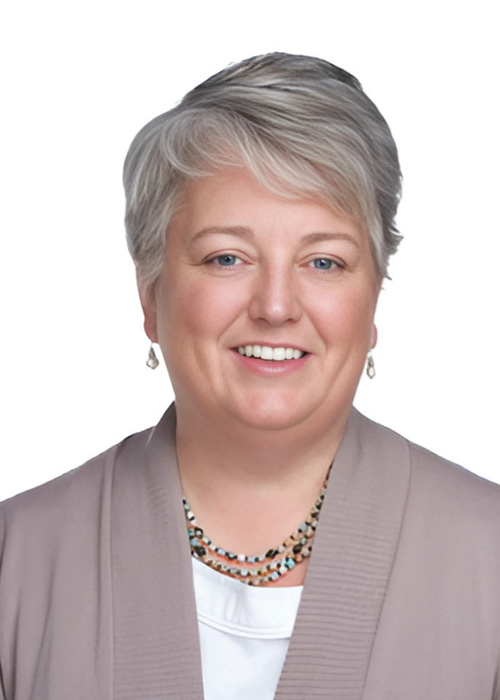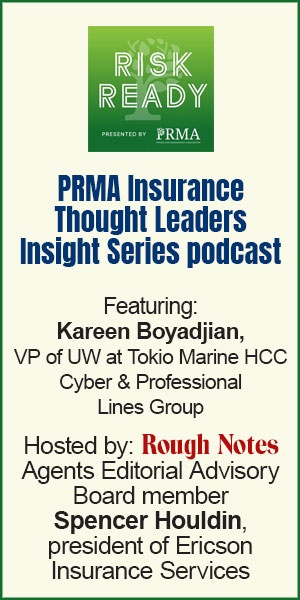Can expanding their vision
of risk help with hard market conditions?
By Joseph S. Harrington, CPCU
In a perfect world, municipalities and other local public bodies would be the second line of defense for individuals, households, and commercial establishments threatened with injury or damage. The first line of defense would be their own safety and security measures backed up by private insurance.
As a practical matter, however, local government is typically for the first line of defense against both natural and manmade accidents and catastrophes, because private methods for preventing and recovering from loss are either inadequate or not in place at all.
Think of older structures not built to the latest fire and electrical codes, or even modern structures without functioning or well-maintained fire suppression systems. Think of the aging infrastructure of roadways and utility systems. Think of existing property developments in flood-prone areas. And think of how law enforcement, established to protect communities, has become a target for liability actions against municipalities.
Then consider how insurance for the losses posed by these hazards is increasingly limited in amount and scope, or not present at all.
That’s the situation as it exists today as municipalities struggle in a hard market to insure their own property and operations, while their communities and tax bases are vulnerable to loss.
Property risk challenges
“Municipalities continue to experience hard market challenges,” says Sue Coates, president of Trident Public Risk Solutions. “Catastrophe and non-cat losses in first party lines have been impacted by inflation and the volatility of increasing climate risks.
“Severe convective storms and the flooding that follows are the predominant peril in many parts of the United States,” she says. “Aging infrastructure and high inflation (in construction costs) exacerbate the challenges.”
In response to those challenges in first-party property risk, Coates sees larger municipalities assuming higher deductibles and exploring the possibilities presented by parametric risk contracts.
Parametric risk contracts are agreements to pay the insured a sum of money upon the occurrence of an event of a certain magnitude (the “parameter”), such as a hurricane that attains certain wind speeds. At least some, and perhaps all, payments under a parametric risk contract are made before the actual extent of losses is determined.
Under parametric risk contracts, issuers know almost immediately what their loss exposure is, and buyers receive payments quickly. However, both the issuer and the buyer bear “basis risk” that the amount paid will not correspond to the actual losses.
“Parametric agreements present an enterprise risk management opportunity for municipal buyers,” Coates says. “As a complement to traditional property insurance, they can serve as a hedge for taking greater risk in the form of higher deductibles. They can also be designed to help pay for indirect losses that may not be covered under property insurance, such as the extra expense required to pay overtime for recovery crews.
“Parametric agreements have gotten traction where there is a history of weather-related events and are starting to make their way into conversations outside of catastrophe prone areas,” Coates says.
Liability losses
As for liability exposure, Coates says that municipalities are seeing increases in loss severity in professional lines, particularly for law enforcement and employment practices. “Exposures arising from police departments, ranging from liability to auto to employment practices to workers compensation, are hot button issues,” she says.
That “hot button” scrutiny dates from at least 2020, when the killing of George Floyd brought long-simmering concerns over police conduct to a boiling point. That time roughly coincided with the beginning of a hard market for law enforcement liability coverage, according to Jason Hoover, senior vice president of professional lines for Kinsale Insurance.
“The law enforcement landscape led carriers to reduce limits and increase rates,” Hoover says. “These headwinds continued until 2024.”
According to Hoover, retrenchment by some carriers created opportunities for others. “For example,” he says, “we commonly saw carriers reduce a $10 million limit for law enforcement to $5 million at renewal. This created opportunities for the second $5 million layer of a law enforcement tower. This has led to more competition, which led to fewer rate increases for law enforcement liability coverage.”
By mid-2024, Hoover found more and more carriers reintegrating law enforcement liability into their municipal liability package policies, as well as increased limits offered by monoline law enforcement liability writers.
“The climate of public opinion surrounding law enforcement has calmed some, which has contributed to the softening in the market,” Hoover observes. “But it’s still a volatile line of business from a claims frequency and severity standpoint.”
“For municipalities that don’t employ a dedicated risk manager, it is especially important to work with an insurance provider that also provides value-added services, such as claim reviews, statutory inspections, employee training, location surveys, and best practices for risk management.”
—Sue Coates
President
Trident Public Risk Solutions

Risk management
Publicly scrutinized municipal budgets are “extremely sensitive” to unanticipated costs of risk, be they premium increases or claim costs, according to Coates. She finds that larger municipalities employing full-time professional risk managers are prepared to assume higher self-insured retentions than in the past, but that most small municipalities don’t have that luxury.
“For municipalities that don’t employ a dedicated risk manager,” she says, “it is especially important to work with an insurance provider that also provides value-added services, such as claim reviews, statutory inspections, employee training, location surveys, and best practices for risk management.”
Such support may be all the more crucial if program cutbacks underway at the federal and state level have a severe impact at the local level.
“Massive changes in federal policies, and the corresponding threats to federal funding at the state level, will inevitably trickle down to the local level,” Coates says. “Any cut in state funding would put pressure on the local tax base and probably disrupt services in public education, public safety, and public health.
“Hiring freezes, layoffs, and cuts in discretionary services are all possibilities,” she adds. In short, as the need for risk management grows, the resources for implementing it may be severely strained.
In all, she says, “these factors are exerting pressure on insurers to get on top of loss costs and keep pace with trends. This results in year-over-year rate increases, with very little sign of slowing. Municipal risks are complex, and the insurers with appetite for them are limited in number.”
Thinking the unthinkable
For sure, finding and placing insurance for public sector entities is daunting. Suppose the current approach doesn’t even get to the heart of the real risks municipalities face?
That’s more or less the view of Charlie Sidoti, who spent nearly 19 years with St. Paul Companies and One Beacon and another eight years in risk consulting analytics before becoming executive director of InnSure, a nonprofit organization dedicated to fostering innovation in insurance.

“Fifty percent of catastrophe damage is uninsured, yet insurance is one of the most effective and efficient ways to handle losses. No one calculates the expense ratios on public disaster relief.”
—Charlie Sidoti
Executive Director
InnSure
As Sidoti sees it, a municipality must look far beyond its property and staff to assess the true scope of its risk. Given ever more intense weather disasters attributed to climate change, he says American communities must ask themselves what was previously unthinkable: Is it possible they might never recover from a weather disaster?
“It was not until recently there would be a question whether a community would ever recover,” he says. “With the scale of losses today, you can’t assume a community will stay around anymore.”
Those losses, Sidoti posits, arise from the myriad gaps in insurance coverage in a typical community. Few properties are covered for flood or earthquake loss, many insured properties are underinsured for actual replacement cost, few renters are insured for additional living expenses, and the list goes on.
As a result, the viability of a community is at risk when there is a catastrophic loss to its economy and livability. It means little that public buildings are insured if the tax base to sustain their services is eroded.
“Fifty percent of catastrophe damage is uninsured,” Sidoti adds, “yet insurance is one of the most effective and efficient ways to handle losses. No one calculates the expense ratios on public disaster relief.”
Embedded “micro” coverage
In its quest to “reimagine” insurance for 21st century needs, InnSure is promoting, among other things, initiatives to have municipalities provide incentives for property owners to “embed” often-overlooked insurance coverages, even in small (“micro”) amounts, into their operations.
As an example, he notes that New York City pays for dozens of renters to stay at hotels every night because of apartment fires. Sidoti says the city could save millions each year if additional living expense coverage, even for one night, were embedded in apartment leases.
“The climate of public opinion surrounding law enforcement has calmed some, which has contributed to the softening in the market. But it’s still a volatile line of business from a claims frequency and severity standpoint.”
—Jason Hoover
Senior Vice President, Professional Lines
Kinsale Insurance

Among other things, InnSure is a champion of “Community Development Reinsurance Institutions,” nonprofit organizations working with lenders, public agencies, and philanthropic organizations, as well as for-profit and mutual insurers, to expand the scope of risk-sharing within communities.
This community-centered approach is designed to contrast with risk-sharing that relies almost exclusively on private insurers who select (or ignore) risks among disparate areas based on company underwriting strategies.
InnSure’s vision is ambitious to be sure. But even if it falls short of winning support for the “bold reimagination” of risk finance Sidoti says we need, InnSure will put a spotlight on the need for more comprehensive financing of community risks.
For more information:
InnSure
innsure.org
Kinsale Insurance
kinsaleins.com
Trident Public Risk Solutions
paragoninsgroup.com/our-brands/trident-public -risk
The author
Joseph S. Harrington, CPCU, is an independent business writer specializing in property and casualty insurance coverages and operations. For 21 years, Joe was the communications director for the American Association of Insurance Services (AAIS), a P&C advisory organization. Prior to that, Joe worked in journalism and as a reporter and editor in financial services.






